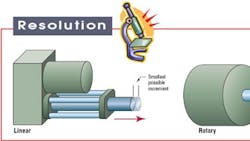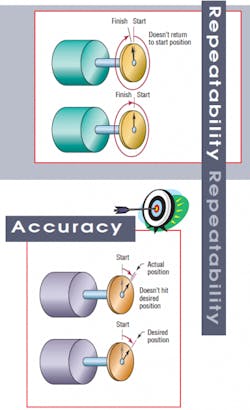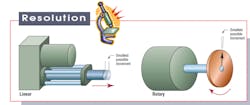Instead of relating to a measurable quantity — like rpm or ips in the case of speed — precision is more the net result of several other variables, including resolution, accuracy, and repeatability.
Resolution is the smallest position increment achievable with a particular actuator. It can be linear or axial. In a digitally controlled system, resolution is the shortest specifiable move. It is influenced by every component in the actuation mechanism.
Accuracy is the maximum error between expected and actual position following a move. It too can be linear or axial, and it includes the effect of backlash and hysteresis.
Repeatability is a measure of how close a positioning system can return to a given starting point. To eliminate the effect of backlash and hysteresis, the actuator must approach the target position from the same direction, at the same speed and deceleration rate, and under the same load conditions.
Backlash, another important factor, is the amount of play (lost motion) between a set of moveable parts. As parts wear and deform, backlash usually increases. Like accuracy, backlash is a noncumulative form of error.
Q: Where does backlash show up?
A: Backlash is a factor in accuracy. It may also be a factor in repeatability when the return cycle involves a change in direction, speed, or load.
Q: Is it possible for an actuator to be repeatable without being accurate?
A: Yes. An actuator can consistently miss its target by the same amount on each cycle.
Q: Is resolution the same as precision?
A: Although some people use the terms interchangeably, resolution is just a part of precision. High resolution usually translates to smooth, quiet actuation, but it can be costly in terms of speed, complexity, and price.Thanks to Oriental Motor USA Corp. and Danaher Motion’s Industrial Devices Corp. for information appearing in here.
About the Author
Elisabeth Eitel
Elisabeth Eitel was a Senior Editor at Machine Design magazine until 2014. She has a B.S. in Mechanical Engineering from Fenn College at Cleveland State University.



